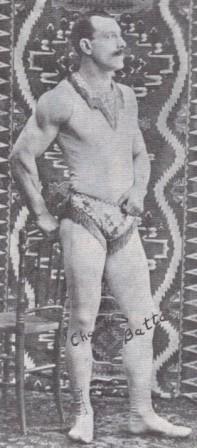Charles Batta
by Dennis Mitchell
Charles Batta, whose real name was Charles Estienne, was born August 17, 1866 in Lille France. It was evident even as a young boy that he had unusual strength. Batta never wanted to be a competitive weight lifter. His ambition was to be strongman performer, and he started his career at age fifteen performing in local cafes. His earnings came from the donations of the patrons. He later joined a troupe of traveling athletes. It was not an easy life, and there was no guaranteed income. They traveled by wagon from city to city performing at fairs and celebrations. He considered this to be his apprenticeship. He was quite successful and became quite famous as a strong man. This, however, made some of the bigger and more experienced performers envious of his success. One performer became so angry that he broke a chair over Batta’s head. Batta’s earnings progressed from the spectators donations to a salary of one franc per day, then to 25 francs per week, and by the time he was nineteen yeas old, to 50 francs per day. Again his success had the disadvantage of enraging one of his fellow performers, a giant of a man named Lepi who forced Batta into a fight. Batta was never a person who would back down from a fight or a challenge. He beat Lepi so badly that he was never bothered by any other performer. While performing in Brussels at the Alcazar Cafe Concert, he was earning 70 francs per day. On day while the performers were at dinner, Louis Attila walked in with one of his pupils who was seeking employment at the Alcazar. While waiting for the manager to return Attila’s pupil started to demonstrate the strength of his grip, using chairs and other objects at hand. He stated that no one could duplicate his feats of hand strength. Batta took the challenge and duplicated all of his lifts. Attila’s pupil did however go on to become quite famous under the name of Eugen Sandow. One of Batta’s demonstrations was, while seated, to hold his hand, palm down about one half inch over an upright needle. A forty four pound block weight was placed on the back of his hand. He would hold it there at arms length for about eight seconds, and then stand up still holding the weight at arms length. Though primarily a performer Batta could one arm snatch 154.5 pounds, put over head 209 pounds with one hand, and hold by the ring a weight of 55 pounds at arms length. During his performance he would lift 259 pounds over head with ease. One of Batta’s challenges was to place a glass of water, a bottle, some gold rings and other jewels plus some gold coins on the seat of a straight back chair. He would then lift the chair with one hand at arms length by one of the horizontal rungs and not spill any of the water. He offered what was on the chair to anyone who could duplicate his lift. No one ever did. Batta’s performance included lifting a horse, a muscle control demonstration, lifting weights and people. In the support known as the “Tomb of Hercules” he would support a loaded cannon which was then fired by an assistant. The only contest that Batta did not win was against the famous Apollon. He did duplicate one of Apollon’s feats by lifting four 44 pound block weights over head with one hand, each weight tied to a finger. He also cleaned (not jerked) Apollon’s rail road wheels. Apollon was so impressed with Batta that they remained friends for life. No strong man article is complete without a list of his measurements. At the age of nineteen Batta stood 5’9.5″, weighed 194 pounds, chest 49″, biceps 17″, forearms 14.5″, waist 33.5″, thighs 25″, calves 16.25″ neck 17.25″, and wrists 8.5″. Charles Batta died June 7, 1931 at the age of 65 yeas.
